Menu

Did you know that Executive Order 12898 tells agencies to help minority and low-income people? This includes making sure they aren’t hit harder by problems from agriculture. It shows how important it is to connect environmental justice with agricultural rules. It underlines the need for fair food growth and policies that help farmers sustain their land.
For farming, environmental justice means everyone, especially minority and low-income groups, can join in and gain from farming plans. The USDA made Departmental Regulation 5600-002 in December 1997 to follow Executive Order 12898’s goals. The main aim is to avoid or lessen how much USDA plans could hurt these groups. They also want to support them in environmental talks.
Environmental justice is about fair rules in farming that involve everyone. The USDA works with many groups to make sure our farms are safe for all. They help us make laws and practices that help everyone, not just some people.
The EPA is also a key player. It gives money to local projects that make our health and environment better. By hosting webinars and using special tech, it helps make better policies. This makes sure fairness isn’t just a word but something we see in action.
The USDA and others are pushing for better, greener farms. They help with training and give useful webinars. This training helps keep our communities, especially the vulnerable ones, safe and strong.
| Agency | Initiatives |
|---|---|
| EPA | Environmental Justice Small Grants, Webinars on NAAQS, EJSCREEN, EnviroAtlas |
| CDC | Training on Health Equity and Environmental Justice, Webinars on Geographic Information Science, COVID-19 and health disparities research |
| NIH | Partnerships for Environmental Public Health webinars |
| Bureau of Indian Affairs | Tribal Climate Resilience training resources |
Making sure all communities get the same environmental protection is very crucial. There have been big fights, like in Warren County, North Carolina. Research shows that areas with toxic waste are often where poor, Black, and Latine people live. This must change, as it harms the most in need.
Learning from people like Dr. Robert Bullard, the fight for environmental fairness continues. By sticking to strict laws and ethical farm practices, we can have farms that work for everyone. This makes our communities safer and stronger.
The fight for fair treatment in farming has its beginnings in community action. People joined together to speak out about the harm from the environment. This harm often hits those with little power the hardest.
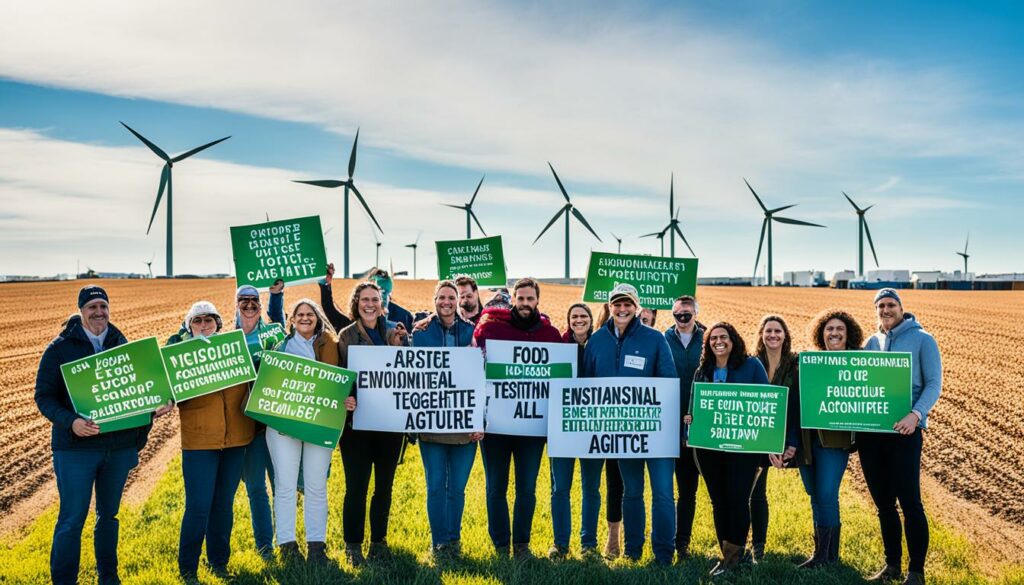
Work for fair rights in farming picked up speed in the 1960s. Back then, the Memphis Sanitation Strike highlighted the need for better working and living conditions. Civil rights activists realised that fighting for labour rights also meant battling for a cleaner, safer environment.
Key events have marked the path for environmental justice in farming:
These events underline the ongoing fight against harmful environmental practices. The goal is to reduce the burden on those often hit the hardest.
The USDA is dedicated to pushing forward environmental justice. It works closely with both government and non-government groups to tackle environmental risks. This goal is backed by rules like Departmental Regulation 5600-002 and Executive Order 12898. These rules make sure that environmental justice is at the core of what the USDA does. They are there to protect communities from being hurt too much by environmental dangers.
Starting on December 15, 1997, Departmental Regulation 5600-002 details the USDA’s stance on environmental justice. It aims to cut down on the health or environment dangers facing minority and low-income groups. A key part is checking how USDA programs affect these groups. This check ensures that everyone fairly enjoys agricultural activities.
Issued on February 11, 1994, Executive Order 12898 is a key part of the US’s push for environmental justice. It tells federal groups, USDA included, to really think about how their actions affect health and the environment in minority and poor communities. This order wants to mix in science and health advice. It’s goal is to help communities more and make the environment safer.
The USDA uses many ways to look at and reduce the harm its work may cause. It gathers and checks data to see how programs affect different ethnic groups and the poor. These groups are identified by information from Census Bureau reports.
The USDA’s guidelines focus a lot on making sure that environmental harm is not unfairly felt by some. They check how people who rely on fishing, hunting, and such might be affected. The USDA also looks at how damage to community unity and resources can be avoided.
| Key Dates | Regulation/Order | Main Focus |
|---|---|---|
| February 11, 1994 | Executive Order 12898 | Consider environmental and health impacts on minority and low-income populations |
| December 15, 1997 | Departmental Regulation 5600-002 | Integrate environmental justice into USDA functions and evaluate program effects |
The USDA sticks closely to these guidelines. It aims to keep leading in making sure everyone is treated fairly when it comes to the environment and health.
Agricultural rules often hit minority groups harder, showing big gaps in how people live and their health. These include American Indian, Alaskan Native, Asian, Black, and Hispanic people. They’ve faced more problems because of harmful effects on the environment.
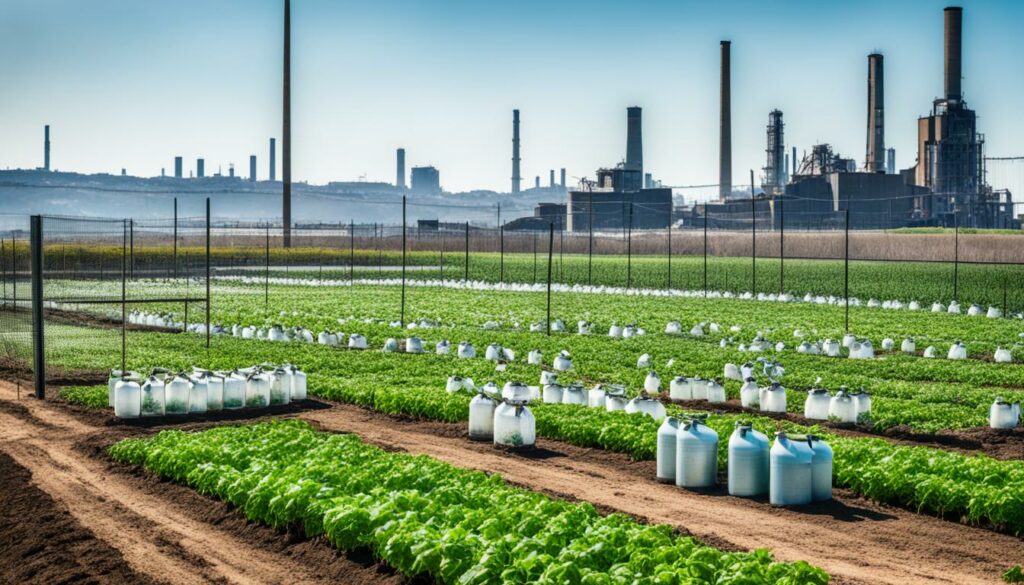
The USDA sees minority groups as having many different ethnic backgrounds. It’s key to make sure their needs are met fairly in environmental and agricultural policies. The USDA looks at American Indian, Alaskan Native, Asian, Black, and Hispanic communities. It’s important they aren’t hurt more by bad environmental rules.
| Minority Population Group | Description |
|---|---|
| American Indian or Alaskan Native | Indigenous peoples with historical ties to North America. |
| Asian or Pacific Islander | Individuals from the Asian continent or Pacific Islands. |
| Black (not of Hispanic origin) | Persons with African ancestry, excluding Hispanic ethnicity. |
| Hispanic | Individuals with roots in Spanish-speaking countries. |
The USDA works hard to lessen bad effects on minority groups. Their rule, Departmental Regulation 5600-002 since 1997, says to think about environmental justice. This help comes from Executive Order 12898, which tells federal groups to deal with issues that mainly affect minority health or the environment.
USDA uses data to find and tackle problems its programmes cause. For example, they found pesticides hurt Black and Mexican American people more. They also work hard to make sure everyone has a say in rules. This includes treating everyone fairly.
Stopping bad impacts early and talking openly with minority groups is very important. The USDA wants to make sure everyone gets treated right and has the same health and environment chances.
The USDA is focused on fair treatment, especially for low-income people. They use data to find out who needs help the most. This often includes those affected by agricultural activities the most.
For example, certain groups like Black or Mexican Americans are more exposed to harmful pesticides. They can show more risks by up to five times than white people. This shows the urgent need for policies that help reduce these risks.
USDA’s way of checking how their policies affect people is very important. They regularly look at how their work influences the environment and people’s health from different backgrounds. This is how they make sure their help really reaches those in need.
Between 10,000 to 20,000 workers, mainly Latinx, get sick every year from pesticides. But, only a few farms get checked each year, and about half show rule-breaking. This shows why we need strict rules to protect these workers and the environment.
Low-income people also often live near places that make pesticides. These places sometimes don’t follow the rules. The USDA gathers info on how these groups eat, like if they fish or hunt. This data helps make better policies to help and protect these communities.
| Statistics | Figures |
|---|---|
| Annual illness among Latinx agricultural workers due to pesticide exposure | 10,000 to 20,000 |
| Inspection rate of pesticide-using operations | Just over 1% |
| Percentage of people of colour living near violating pesticide manufacturing facilities | High |
| Number of USDA agencies subject to Departmental Regulation 5600-002 | Multiple |
In sum, helping low-income and minority groups through better agriculture rules is vital. Making sure they are protected is key to environmental justice. We must keep working hard to make these rules better for everyone’s benefit.
Following environmental laws is key to fair and eco-friendly farming methods. We must know and stick to rules like NEPA and Title VI of the Civil Rights Act. These are very important for making sure the environment is just for everyone.
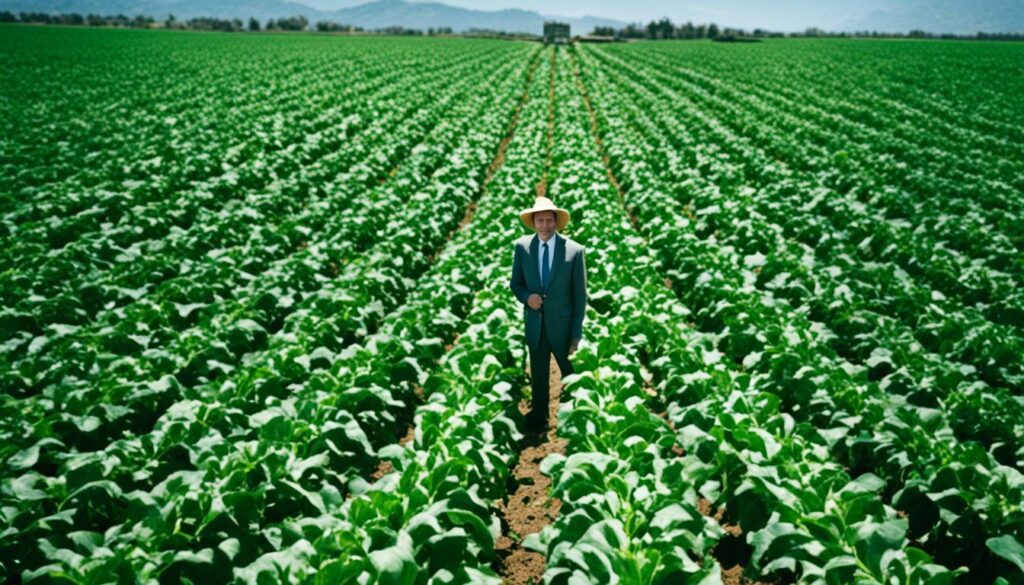
Being on track with the NEPA rules means understanding and revealing possible harm to the environment. For example, 6 USDA groups have learned about considering environmental justice in their reviews. This helps in making sure projects don’t hurt minority or poor people’s health and environment actions.
Keeping up with Title VI stops unfairness in projects that get federal support. It’s crucial that USDA projects work well against environmental and health differences. Right now, there’s an investigation showing we need to keep working hard on this. If we are careful to follow both NEPA and Title VI well, we can better achieve real fairness in the environment.
Sustainable farming is key to environmental justice, which helps both the environment and farming groups. The USDA is at the forefront of pushing for eco-friendly farming. They focus on programmes that keep a balance with nature while saving resources for the next generation. Because the way we grow our food today fills one-third of our country’s sky with harmful gases, switching to green farming is a big step.
The USDA is actively pushing for more green practices on farms. They provide training and money to help farmers make the switch to eco-friendly ways. Many farmers are now using earth-friendly practices like growing plants all year round, changing which crops they plant, and adding cover crops. These methods save our environment, keep our soil healthy, stop land from washing away, and help the ground keep water better.
Sustainable farming comes in many forms, all aiming to cut harm to our planet while still growing lots of food. Here are some top examples:
Favour for sustainable farming has grown with calls to improve laws and policies from both farmers and those who make the rules. Earthjustice has been a key player in promoting friendly farming through the courts. More studies, help, and finance can encourage farmers to use these better ways, making agriculture more fair and lasting.
The USDA’s efforts in sustainable farming and environmental justice are detailed below:
| Category | Number of Activities | Description |
|---|---|---|
| NEPA Reviews Training | 6 USDA agencies | Conducted training on environmental justice considerations during NEPA reviews. |
| Title VI Investigations | 1 | Open Title VI investigation or compliance review related to environmental justice. |
| Public Processes | 25 | Public processes related to environmental justice, e.g., requests for information or listening sessions. |
| Tribal Consultations | 26 | Tribal Consultations related to environmental justice from January 2021 to September 2022. |
Getting farms to use sustainable methods is a big part of making agriculture fair and green. It needs us to keep on teaching, helping, and showing that these eco-friendly ways are the best choice.
Eco-friendly agricultural policies are key for a better farm sector. They aim to protect the environment and save resources. This is vital for the future of farming.
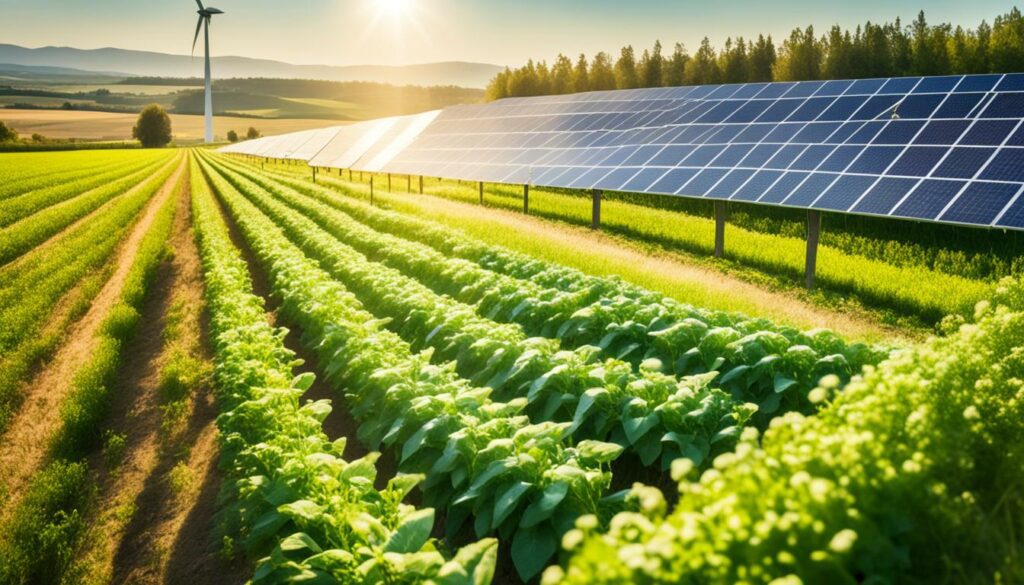
The food industry often releases lots of greenhouse gases. This harms the environment. Thus, turning to organic farming can help. It uses fewer harmful chemicals and cares for the soil.
Currently, public money goes to support crops that harm the planet. It’s time to change this support to eco-friendly practices. Luckily, more people want to see agricultural laws improve. This opens the door for better, greener farming methods.
Organisations like Earthjustice have fought for cleaner industries. They show us how to make agriculture more eco-friendly. The USDA is also working to make farming fairer and greener.
There have been many talks on these issues recently. These discussions are important. They help make sure the new policies are good for everyone and the Earth.
Here’s a summary to show why we need to change our farming ways:
| Statistic | Details |
|---|---|
| Greenhouse Gas Emissions | One-third of the nation’s total emissions from the food system |
| Taxpayer Subsidies | Billions of dollars annually on wasteful crops |
| USDA Training | 6 agencies with trainings on environmental justice |
| Public Processes | 25 related to environmental justice |
| Tribal Consultations | 26 from January 2021 to September 2022 |
We can make farming greener by supporting these policies. It will help save the planet and our food. The time to act is now.
Fair trade rules are key in creating fairness in farming and work practices worldwide. They help over 500 million small-scale farming families make a better living. These families depend on farming for their income.
Fair trade is crucial for protecting our environment. It ensures farmers are paid fairly and work in safe conditions. Fairtrade focuses on bettering soil and water, cutting down on harmful emissions, and saving wildlife. This helps make farming better for the environment and the people involved.
Making farms sustainable is vital for their future success. Fairtrade helps farmers use greener and more durable farming methods. They support the use of farming practices that are good for the environment and help farmers cope with climate change.
Farmers get help to deal with climate change, thanks to things like Fairtrade Carbon Credits. These credits help them fight the negative impacts of a changing climate. The Fair Climate Fund also helps by investing in projects that reduce carbon emissions. This support is a big step towards keeping farms sustainable.
| Measure | Impact |
|---|---|
| Improving Soil and Water Quality | Enhances crop yield and sustainability |
| Reducing Greenhouse Gas Emissions | Mitigates climate change effects |
| Protecting Biodiversity | Maintains ecological balance |
| Access to Fairtrade Carbon Credits | Provides financial support for climate adaptation |
Furthermore, Fairtrade has strict rules against deforestation and harmful chemicals. These rules ensure all farming practices are sustainable. They help farmers and protect the environment, which is crucial for the future.
It is crucial to involve communities in making decisions about agriculture. This approach helps everyone’s voice be heard in shaping policies that directly affect them. 
The USDA has started several programmes to get people more actively involved. For example:
Information from the USDA shows that many communities are getting involved in making things fairer:
| Activity | Count |
|---|---|
| NEPA-Related Environmental Justice Trainings by USDA Agencies | 6 |
| Title VI Investigations or Compliance Reviews | 1 |
| Public Processes on Environmental Justice | 25 |
| Tribal Consultations on Environmental Justice | 26 |
The USDA’s Justice40 scheme aims to make decisions in farming more fair. It plans to give 40% of government money to communities that need it most, focusing on making everyone’s voice count.
The Federal Government is committed to helping people and places protect public health and the environment across the country.
They also provide tools like the Environmental Justice Screening and Mapping Tool. This gives easy-to-understand information on environmental and health problems. It helps people make better choices and talks clearer between leaders and communities.
By working together under the USDA’s leadership, decisions on farming are made fairly and include everyone. This helps create farming rules that are good for the planet and for all people involved.
In New York City, the Mayor’s Office of Urban Agriculture and the Urban Agriculture Advisory Board have made a big difference. They improve farmer training and access to help with farming. These efforts are part of Local Laws 121 and 123, aiming to create a report, an online hub, and outreach programs.
The USDA helps farmers learn about environmental rules. This farmer training is key for using farming methods that are safe for the planet. Farmers get to attend workshops and learn how to follow the rules well. This helps in protecting the environment.
Farmers need good resources to follow rules and do well. The Urban Agriculture Advisory Board, with top farming experts, helps by sharing updates on grants and plans to keep nature safe. This year, the City got a big funding boost, like $200,000 from the USDA for school farming and $8.4 million for local food.
| Funding Source | Amount | Purpose |
|---|---|---|
| USDA and NYS Department of Agriculture | $200,000 | Farm-to-School Programs |
| NY State Department of Education | $8.4 million | Local Food for Schools |
The Mayor’s Office is launching a new site in early 2023 to help farmers even more. This site will have maps, tools, and info on city programs. Farmers can use it to understand and meet farming laws better, ensuring they keep getting help with their work.
Case studies are valuable for understanding environmental justice in farm rules. They show us what works well and point out key things to remember for future laws and ways of doing things.
In 1997, Departmental Regulation 5600-002 showed a strong move towards fairness. This move was in direct response to a 1994 order. It made sure farming projects think about justice for all when they work. This was a big win mainly for those with less and the poorest, dealing with pollution and moving from their homes.
The Environmental Health Perspect study in 2002 highlighted the social responsibility and research ethics in community-driven studies of industrialised hog production, reflecting a significant stride towards incorporating environmental justice into agricultural regulation.

In late 1997, a guide was published about using pig poo safely by the North Carolina service. It aimed to help farmers handle waste in better ways. This was good for the land and the poorer and minority groups living nearby, meeting USDA’s fair farming targets.
We learn a lot from looking at these cases. First, it’s super important to keep track of how farming work affects the least fortunate. Doing tests on the air, water, and output of farms, as we saw in reports from 2007 to 2013, helps in making sure the bad effects are kept in check.
| Case Study | Year | Focus | Key Findings |
|---|---|---|---|
| Environmental Health Perspect | 2002 | Hog production | Social responsibility in agricultural practices |
| North Carolina Cooperative Extension Service | 1997 | Swine manure | Sustainable waste management |
| USDA Regulations | 1997 | Program impacts | Enhanced data-driven decision-making |
| Various Studies | 2007-2013 | Environmental Effects | Improved community health and safety |
Keeping communities involved as actions are planned is a key lesson. It makes sure the implemented changes are right and well accepted. Also, sharing important knowledge and tips, like the EPA’s advice in 2004 on handling waste, is key. It helps everyone in farming follow the right path, making our environmental fairness goals stronger.
There are big challenges in making sure environmental justice happens in agriculture. The 1983 Government Accountability Office (GAO) study found that hazardous waste sites were often put in poor Black and Latine areas. This shows how unfair the situation is, hurting those who are already struggling the most.
Places for hazardous waste were unfairly chosen based on race, as the CRJ’s 1987 report and Robert Bullard explained. Bullard’s book, ‘Dumping in Dixie: Race, Class, and Environmental Quality’, highlights that race plays a major part in the placement of these harmful facilities. To achieve fairness in agriculture, we must tackle these racial differences.
Since 1990, leaders in environmental justice highlighted a big issue. They said the policies and organisations looking after the environment often help White people more. They don’t help the people of colour and those living in poorer areas enough. This makes it hard to stop the harm caused by pollution in these places.
The problems are getting worse because of climate change. Bad events like droughts, floods, and heatwaves hurt those who can’t easily recover, like the poor and people of colour. Agriculture is a big part of what causes climate change. About 60% of harmful emissions come from producing meat and dairy. This is why we need to change the way we farm to protect the environment and help people survive these hardships.
To get over the problems in agriculture, the answer is agroecology. This means that when things go wrong, farmers can still earn a living. It’s important that poor farmers and those in the southern parts of the world get help during these changes. Making sure they are supported is key.
Women face a lot of problems too, even though they make up many of the farmers. They don’t often get the same chances as men. Making changes means listening to everyone involved and making sure they can help decide on the best way forward.
Change in agriculture should make things fairer and better for the planet and people. It’s about completely changing how we grow food to make sure everyone wins. This kind of change should be fair, good for the environment, and follow true justice principles.
| Key Statistics | Details |
|---|---|
| GAO Study (1983) | Three-quarters of hazardous waste landfill sites in eight southeastern states located in low-income, Black, and Latine communities. |
| CRJ Report (1987) | Race identified as the primary factor in the siting of toxic waste facilities in the US. |
| Agricultural Emissions | One-third of global emissions from agriculture; 60% from animal-based foods like meat and dairy. |
| Food Insecurity | More than 2 billion people worldwide are food-insecure (UN FAO). |
| Climate Change Impact | Increase in extreme weather events affecting the agriculture sector. |
| Women’s Exclusion | Women make up around 50% of farmers in some areas but are often excluded from key resources. |
In looking ahead at how environmental justice links to agricultural policies, it’s clear that where policies are heading is important. These policy trends will define a balanced and nature-friendly farming area. The ultimate aim is for all groups to be part of decisions and to share the benefits equally.
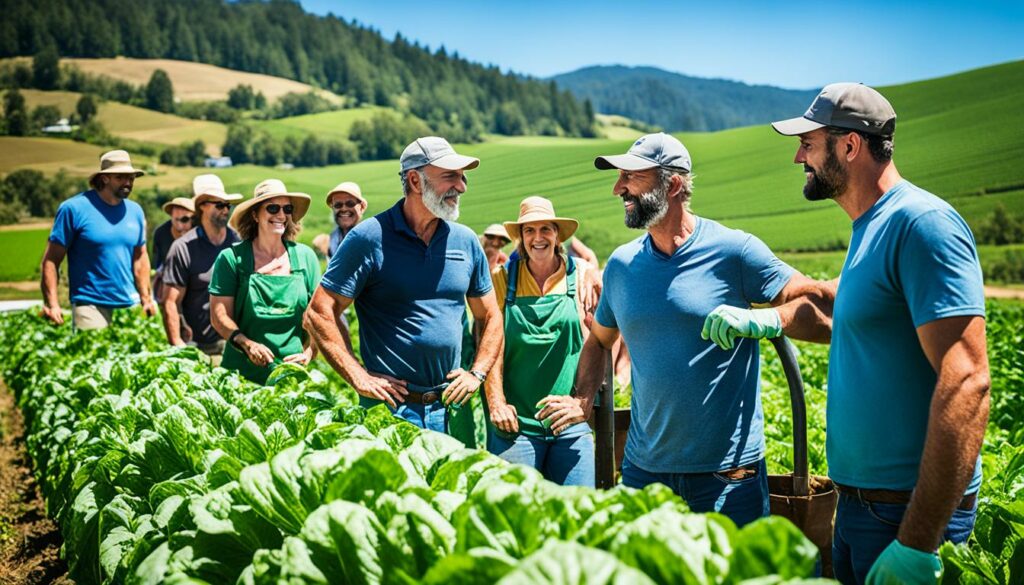
Recent shifts show a stronger push for fairness in how agriculture is planned. For example, six USDA offices are now training to make sure environmental justice is part of reviews. This is a big step towards making choices that are fair and wise for everyone.
Also, the USDA has listened well, holding 25 open events or sent out questionnaires. This deep involvement signifies a leap towards clearness and making sure local voices matter. These aspects are key to the future of being fair to the environment.
To manage the path to fairer environmental justice, several suggestions stand out from what’s already in play:
By including these proposals into upcoming plans, we aim to make the agriculture policy world fairer and open. This way, environmental justice would not be just a big idea but something we all experience.
Improving fairness in farm laws is an ongoing task. On May 5, 2022, the Department of Justice (DOJ) stepped up with new actions for environmental justice. Their goal is to quickly solve environmental issues in areas often left behind. These actions are part of President Biden’s plan, making sure fair environmental treatment is a main concern for the government.
The DOJ set up an Office of Environmental Justice to tackle long-standing problems. This office will make sure health is protected in areas that are overlooked. Also, the new plan will push for good deeds from those who broke the rules. This will help the environment and lower their fines, supporting fair farming practices.
Reports, like the one from the United Church of Christ, show that minority groups face more harm from environmental dangers. Since Executive Order 12898, it’s required that all government departments work on these issues. The DOJ is working closely with others to make sure no area suffers more than others. This aims to make concrete changes in how we care for the environment. With everyone working together and solid plans, making the agricultural sector fairer is not just wishful thinking. It’s something that can really happen.
Environmental justice in agriculture ensures fairness. It helps all people, especially those in minority and low-income groups, benefit from farming fairly. This means everyone should have a say in making and following farming rules.
The movement started with people of colour fighting environmental and economic issues. They faced problems like the Memphis Sanitation Strike and the Northeast Community Action Group’s legal case. Protests in Warren County, North Carolina, also showed their struggles.
The USDA works to be fair through its rules, like Departmental Regulation 5600-002. It tries to make sure that everyone, especially minority and low-income groups, is treated fairly. This means they aim to stop any unfair treatment in farming.
Sometimes, farming rules have a bigger effect on minorities. This includes groups like Asian or Pacific Islanders, Blacks, and Hispanics. The USDA is working to make sure these rules are fair for everyone, giving equal benefits to all.
Policies try to help those facing poverty. They make sure that farming doesn’t make their situation worse. Extra support is also given to help reduce any bad effects.
NEPA makes sure farming’s effects on the environment are understood and shared. The USDA trains its people to think about fairness in these matters. This includes making sure everyone’s needs are heard.
Title VI stops any kind of unfair treatment in projects that get money from the government. This includes those that can affect the environment and health. So, farming rules must make sure to treat everyone fairly.
The USDA backs things like organic farming and keeping the soil healthy. These actions help nature stay in balance. They also help farms last a long time.
Green farming rules aim to protect the environment and its living things. The USDA works on these to keep nature’s resources safe while farming.
Fair trade rules make sure farmers get paid fairly and work in good conditions. This helps make farming fair for everyone and helps keep farms going by using good practices.
Listening to communities helps shape fair farming rules. The USDA wants to hear what people think. They meet with the public to make sure that everyone’s voice is heard.
The USDA trains farmers to follow environmental rules and helps them use the right plans. This helps farmers do their part for the environment and justice fairly.
Showing what’s worked helps make farming fairer. It teaches important lessons for future policies. This is how we make farming better for everyone.
Fighting unfairness and making policies that work for everyone is hard. It needs a lot of work and smart planning. But, we can make things fair by not giving up.
The future is about being fair, supporting what’s good for the environment, and offering equal chances to all. Recommendations for new policies hope to achieve these goals. This is how farming can be fair for everyone in the future.